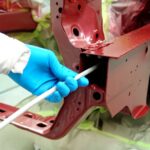Repo car auctions, also known as auto auctions or foreclosure auctions, can be a great place to find vehicles at prices significantly below market value. These auctions feature cars, trucks, and SUVs that have been repossessed by lenders, banks, or other financial institutions due to the previous owners’ inability to keep up with payments. For those looking to navigate this market, understanding how repo car auctions work is crucial. This guide will provide you with a comprehensive overview of the process, from finding auctions to placing your winning bid.
Understanding Repo Car Auctions
Repo car auctions are essentially liquidation events for lenders. When a borrower defaults on their car loan, the lender repossesses the vehicle to recoup their losses. To quickly sell these assets, they often turn to auto auctions. These auctions are different from your typical car dealership experience. You’re buying vehicles that are being sold as-is, often without warranties, and usually with limited information about their history and condition.
The vehicles available at repo car auctions come from various sources, including:
- Bank Repossessions: Cars repossessed due to loan defaults are the most common type.
- Finance Company Repossessions: Similar to bank repos, but from finance companies.
- Lease Returns: Vehicles returned at the end of a lease term, sometimes auctioned if not sold through dealerships.
- Fleet Vehicles: Cars from rental companies or corporate fleets being retired.
The Auction Process: A Step-by-Step Guide
Participating in a repo car auction involves several key steps:
-
Finding Auctions: Repo car auctions can be found both online and in physical locations. Websites specializing in auto auctions aggregate listings from various auction houses. Local newspapers and auction listing websites may also advertise upcoming in-person auctions. Some auctions are open to the public, while others are dealer-only. Make sure to check the auction’s terms and conditions regarding public participation.
-
Pre-Auction Inspection: One of the most important steps is to inspect the vehicles before you bid. Reputable auction sites and physical auction locations often allow potential buyers to inspect the cars during designated preview periods. This inspection is typically limited. You can usually start the engine and check for any obvious mechanical issues or cosmetic damage. However, test drives are generally not permitted for liability reasons.
Alt: Man inspecting car engine at repo car auction, checking for mechanical issues before bidding.
It’s crucial to carefully examine the vehicle yourself or, ideally, bring a knowledgeable mechanic or friend who understands cars. Pay attention to:
- Exterior Condition: Look for dents, scratches, rust, and signs of accidents.
- Interior Condition: Check for wear and tear, damage, and the overall cleanliness.
- Engine and Mechanicals: Start the engine, listen for unusual noises, and check fluid levels if possible.
- Odometer Reading: Note the mileage to gauge the vehicle’s usage.
Keep in mind that auction houses often provide limited information about the vehicle’s history. They might list the odometer reading and title status, but detailed vehicle history reports are usually the buyer’s responsibility to obtain.
-
Bidding Process: Once you’ve identified a vehicle you’re interested in, you need to understand the bidding process. Auctions can be live, online, or a combination of both.
- Live Auctions: In-person auctions are fast-paced and require quick decision-making. You’ll bid against other attendees in real-time.
- Online Auctions: Online platforms offer convenience and a wider selection of vehicles. Bidding can be done remotely, often with extended bidding periods or live virtual auctions.
Before bidding, establish your maximum bid and stick to it. It’s easy to get caught up in the excitement of an auction and overbid. Factor in potential repair costs, auction fees, and taxes when determining your maximum bid.
-
Post-Auction: If you win the bid, you’ll need to complete the purchase process. This typically involves:
- Payment: Auctions usually require immediate payment or a deposit shortly after the auction. Accepted payment methods vary but often include cash, certified checks, or wire transfers.
- Vehicle Pickup: You’ll need to arrange to pick up the vehicle from the auction location within a specified timeframe.
- Title Transfer: The auction house will provide you with the necessary paperwork to transfer the vehicle title into your name. Ensure the title is “clear” or understand any title issues before bidding.
Key Considerations Before You Bid
Before participating in repo car auctions, consider these important points:
-
Vehicle History Reports: Always run a vehicle history report (like Carfax or AutoCheck) using the VIN (Vehicle Identification Number) if available. This report can reveal accident history, title issues (salvage, rebuilt), and odometer discrepancies.
Alt: Example of a vehicle history report showing vehicle information and history details for potential repo car auction buyers.
-
As-Is Sales: Repo cars are typically sold “as-is,” meaning there are no warranties, and you’re responsible for any repairs needed after purchase.
-
Limited Information: Auction houses often have limited knowledge of a vehicle’s past and operating condition beyond what they can visually assess on their lot.
-
Auction Fees: Be aware of auction fees, buyer’s premiums, and other charges that can add to the final cost of the vehicle.
Conclusion
Repo car auctions offer a unique opportunity to purchase vehicles at potentially lower prices. However, success in this market requires careful research, due diligence, and a clear understanding of how repo car auctions work. By understanding the process, inspecting vehicles thoroughly, and setting realistic budgets, you can increase your chances of finding a great deal at a repo car auction. Remember to always prioritize caution and be prepared for potential risks associated with buying vehicles sold as-is.

